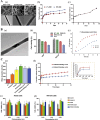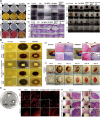Recent progress of electrospun nanofibers as burning dressings
- PMID: 38694552
- PMCID: PMC11061782
- DOI: 10.1039/d4ra01514b
Recent progress of electrospun nanofibers as burning dressings
Abstract
Burns are a global public health problem, which brings great challenges to public health and the economy. Severe burns often lead to systemic infection, shock, multiple organ failure, and even death. With the increasing demand for the therapeutic effect of burn wounds, traditional dressings have been unable to meet people's needs due to their single function and many side effects. In this context, electrospinning shows a great prospect on the way to open up advanced wound dressings that promote wound repairing and prevent infection. With its large specific surface area, high porosity, and similar to natural extracellular matrix (ECM), electrospun nanofibers can load drugs and accelerate wound healing. It provides a promising solution for the treatment and management of burn wounds. This review article introduces the concept of burn and the types of electrospun nanofibers, then summarizes the polymers used in electrospun nanofiber dressings. Finally, the drugs (plant extracts, small molecule drugs and nanoparticles) loaded with electrospun burn dressings are summarized. Some promising aspects for developing commercial electrospun burn dressings are proposed.
This journal is © The Royal Society of Chemistry.
Conflict of interest statement
The authors declare no conflict of interest.
Figures








Similar articles
-
Recent Advances in Electrospun Nanofiber-Based Strategies for Diabetic Wound Healing Application.Pharmaceutics. 2023 Sep 5;15(9):2285. doi: 10.3390/pharmaceutics15092285. Pharmaceutics. 2023. PMID: 37765254 Free PMC article. Review.
-
Electrospun Medicated Nanofibers for Wound Healing: Review.Membranes (Basel). 2021 Oct 9;11(10):770. doi: 10.3390/membranes11100770. Membranes (Basel). 2021. PMID: 34677536 Free PMC article. Review.
-
A review on polysaccharides mediated electrospun nanofibers for diabetic wound healing: Their current status with regulatory perspective.Int J Biol Macromol. 2023 Apr 15;234:123696. doi: 10.1016/j.ijbiomac.2023.123696. Epub 2023 Feb 16. Int J Biol Macromol. 2023. PMID: 36801273 Review.
-
Electrospun nanofibers with antibacterial properties for wound dressings.J Biomater Sci Polym Ed. 2022 Nov;33(16):2165-2183. doi: 10.1080/09205063.2022.2099662. Epub 2022 Aug 24. J Biomater Sci Polym Ed. 2022. PMID: 36001387 Review.
-
Electrospun nanofibers as dressings for chronic wound care: advances, challenges, and future prospects.Macromol Biosci. 2014 Jun;14(6):772-92. doi: 10.1002/mabi.201300561. Epub 2014 Mar 28. Macromol Biosci. 2014. PMID: 24678050 Review.
Cited by
-
Nanofiber-Based Biomimetic Platforms for Chronic Wound Healing: Recent Innovations and Future Directions.Tissue Eng Regen Med. 2025 Aug;22(6):755-770. doi: 10.1007/s13770-025-00729-6. Epub 2025 Jun 13. Tissue Eng Regen Med. 2025. PMID: 40512298 Review.
-
Chitosan-Based Dressing Materials for Burn Wound Healing.Polymers (Basel). 2025 Jun 13;17(12):1647. doi: 10.3390/polym17121647. Polymers (Basel). 2025. PMID: 40574175 Free PMC article. Review.
-
Shell Distribution of Vitamin K3 within Reinforced Electrospun Nanofibers for Improved Photo-Antibacterial Performance.Int J Mol Sci. 2024 Sep 3;25(17):9556. doi: 10.3390/ijms25179556. Int J Mol Sci. 2024. PMID: 39273503 Free PMC article.
-
Recent Progress of Electrospun Nanofiber Dressing in the Promotion of Wound Healing.Polymers (Basel). 2024 Sep 13;16(18):2596. doi: 10.3390/polym16182596. Polymers (Basel). 2024. PMID: 39339060 Free PMC article. Review.
-
Electrospun nanofibers and their application as sensors for healthcare.Front Bioeng Biotechnol. 2025 Mar 20;13:1533367. doi: 10.3389/fbioe.2025.1533367. eCollection 2025. Front Bioeng Biotechnol. 2025. PMID: 40182987 Free PMC article. Review.
References
-
- Qi L. F. Zhang C. L. Wang B. Yin J. B. Yan S. F. Macromol. Biosci. 2022;22:e2100475. - PubMed
-
- Li Z. Y. Zhou F. Li Z. Y. Lin S. Y. Chen L. Liu L. X. Chen Y. M. ACS Appl. Mater. Interfaces. 2018;10:25194–25202. - PubMed
-
- Chen M. M. Tian J. Liu Y. Cao H. Li R. Wang J. H. Wu J. L. Zhang Q. Q. Chem. Eng. J. 2019;373:413–424.
Publication types
LinkOut - more resources
Full Text Sources

